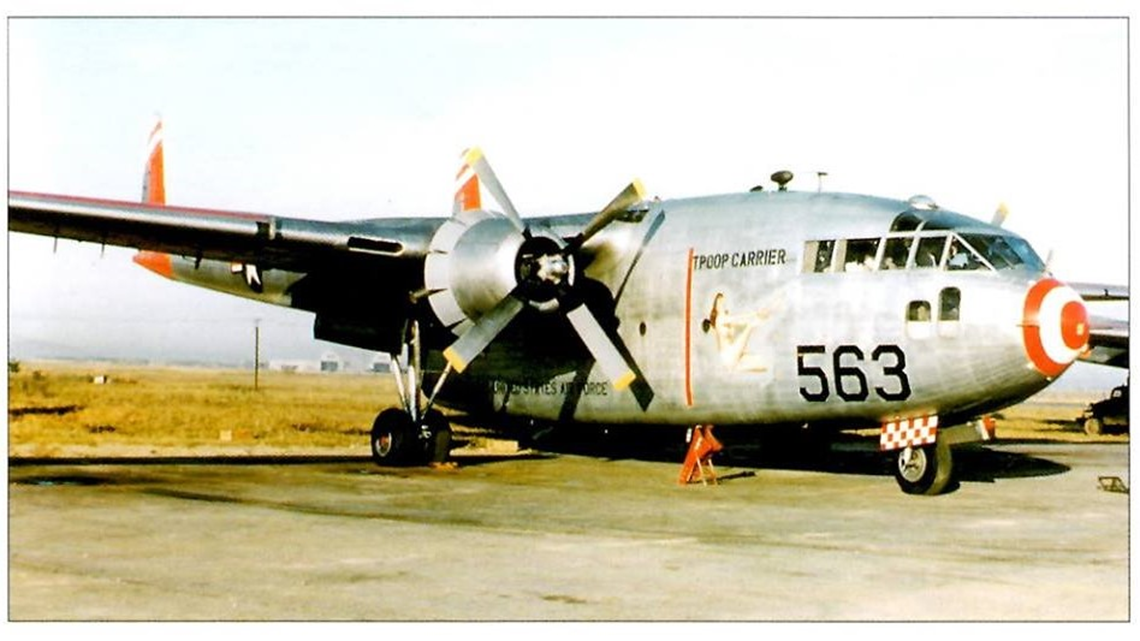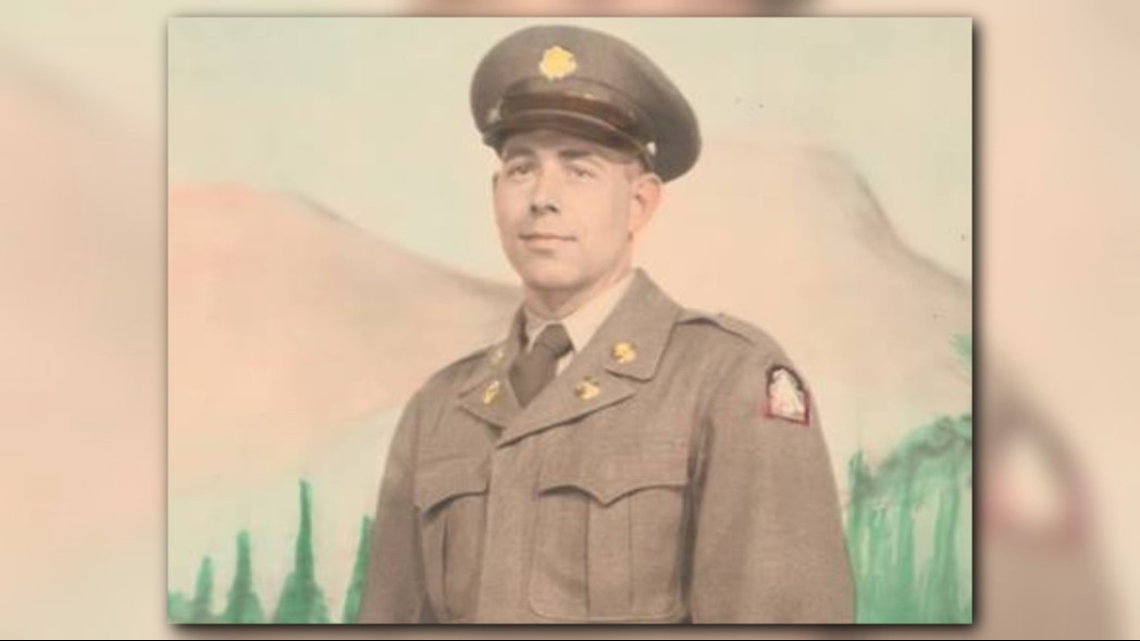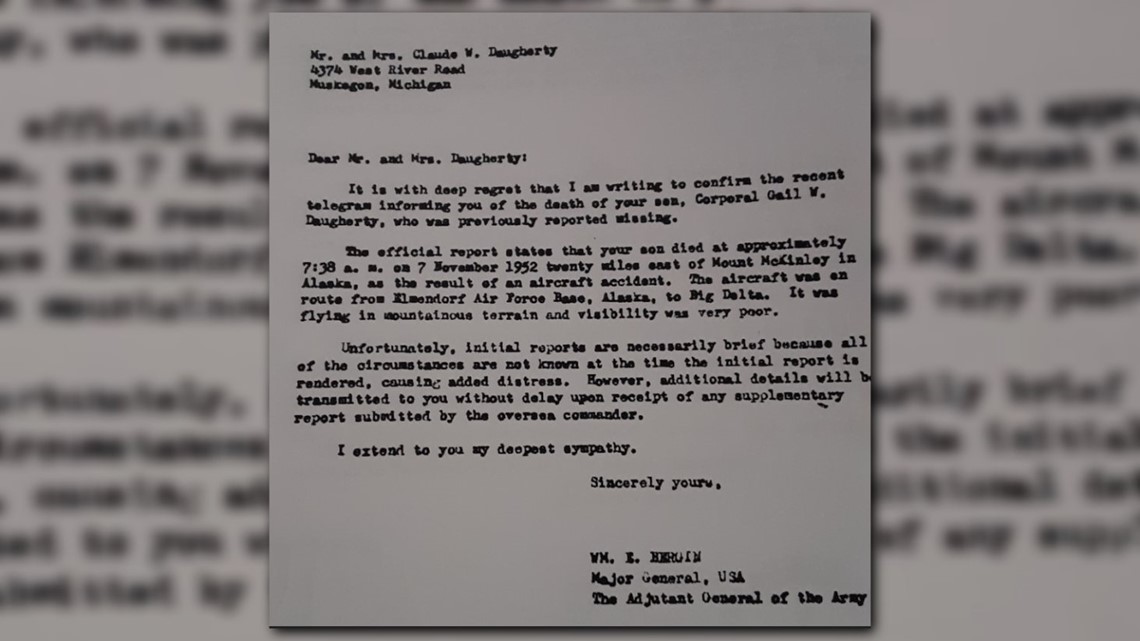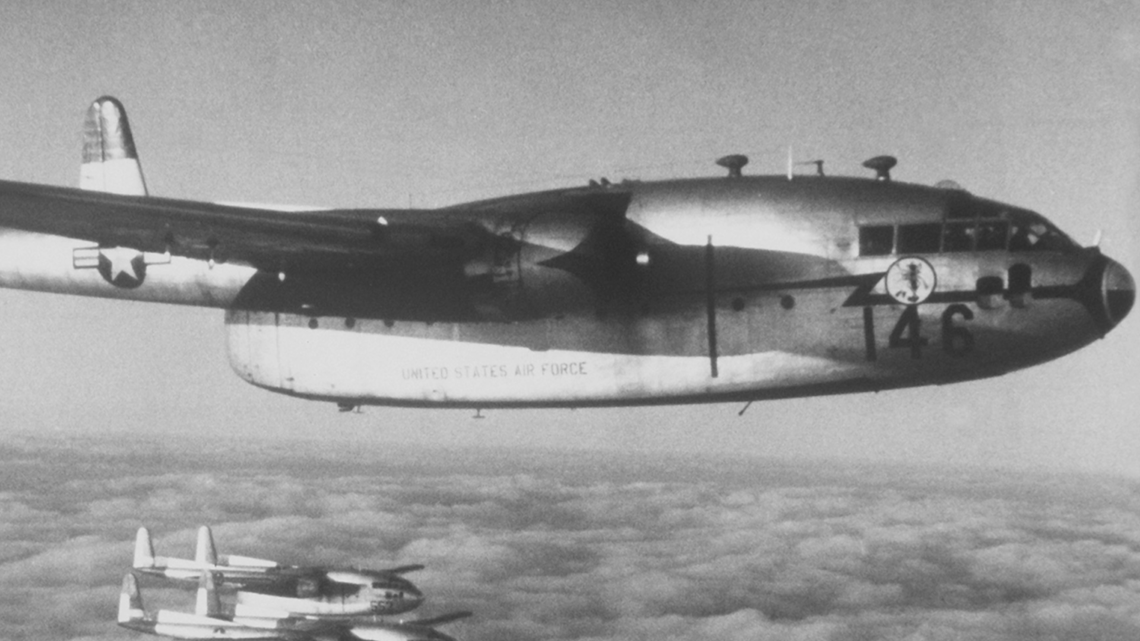MUSKEGON, Mich. — A message on Facebook gave Charles Daugherty hope after learning from his niece that the U.S. military has begun the process of looking for his brother's remains after seven decades.
"It’s been too many years," said Daugherty. "70 years is a long time to be without your brother and not know anything. It’s hard."
U.S. military have begun assessing the area near the plane crash in Alaska, issuing a no-fly zone. The goal is to have boots on the ground, searching for remains next summer.
On November 7, 1952, Charles' brother, Gail Daugherty, along with 18 other servicemen, boarded a twin-engine C-119 Boxcar troop transport plane. It was supposed to be a two-hour flight from Anchorage, AK to Fairbanks.
The plane's call letters were "Gamble Chalk 1."


The plane flew 30 miles off course. The pilot didn't know that a navigational map with a radio frequency was mislabeled. It unknowingly headed toward Mount Silverthrone in Alaska.
Around 3 a.m., the plane crashed into the ridge just below the peak of the mountain.
All 19 servicemen aboard the plane died. A few days later, a reconnaissance plane went out to search for Gamble Chalk 1. However, conditions on the mountain proved too dangerous for the search effort. U.S. Air Force believed that if they had performed a recovery operation, more avalanches would likely be triggered.
Those 19 servicemen's remains were left behind.
70 years later, Daugherty and his family still have no remains of Gale.


"We were always taught never leave a fallen brother behind," said Daugherty. "Well, I believe these are fallen brothers and we left them behind."
In 2016, a retired glaciologist and pilot from Alaska, Michael Rocereta, put his skills to the test. He flew a plane to the Eldridge Glacier to take photos.
After lengthy research, Rocereta found debris from Gamble Chalk 1 scattered over the glacier.




The Daugherty family began working with an advocate named Tonja Anderson-Dell. She has a non-profit called Honored Bound, which helps families like the Daugherty family find closure from operational loss.
"Operational loss, meaning after the initial search, they're going from duty station to duty station, or non war loss," said Anderson-Dell. "There is no agency within our government that looks for them."
After 13 ON YOUR SIDE's original story aired in 2020, local U.S. Representative Bill Huizenga (R-Holland Township), chose to act on behalf of the victim's families.
He revealed an amendment to a bill that would direct the Air Force to give an official report to finding out a recovery plan.
On September 23, 2021, the U.S. House voted to approve a bipartisan defense policy bill that would require the Air Force to report on its plans and timeline for recovering Gamble Chalk 1.
A portion of the plan, drafted by USAF Colonel Chip W. Hollinger, reads in-part:
"AFMAO has been working deliberately with Alaskan Command (ALCOM) to develop a plan for a boots-on-ice mission in the summer of 2022. ALCOM led the initial planning conference in late July with a focus on conducting a reconnaissance flight of Eldridge Glacier in mid-August. Due to weather delays, the reconnaissance flight was postponed, but was successfully conducted on August 30, 2021. The reconnaissance team was able to identify key factors that will assist in the planning process such as terrain features, an area for a weather station and landing zones, elevation, and approximate recovery range. A follow-up planning conference was held in late September to discuss the resources, training, and key personnel required for the planned boots-on-ice mission in 2022. It’s important to emphasize that next year’s boots-on-ice mission doesn’t mean recovery; search and recovery operations are projected for August 2023 in accordance with current planning milestones. Our ongoing planning efforts will continue to ensure all parties involved are equipped to support in the safest, most effective manner. "


In August 2022, the assessment has finally begun to start searching for remains in the summer of 2023.
Anderson-Dell called the moment a "promise kept," referring to the general of the Alaskan base who promised they would get boots on the ground looking for the servicemen's remains.
"This means a lot to me that it's actually happened," said Anderson-Dell. "It's not another year of 'I'm sorry, we couldn't get there.' They're actually doing what I advocated, and what I promised to the families: boots on the ground. Let's start to bring these men home."
The year between assessing and searching is necessary because of the rough Alaskan climate. There is a very small window for search crews, just a few weeks in August without too much snow.
"Because of where it sits, they want to get out there and make sure that they have the proper planes," said Anderson-Dell. "That they have everything that they need to do a recovery safely, not just for the families to get closure, but also making sure the men and women who risked their lives to get out there, that it's a safe environment for them."


For Charles Daugherty, news of the search was "a long time coming," but not necessarily a joyous moment.
"I felt sad," said Daugherty. "Knowing and hoping it comes before me or my sister passes away."
He said two of his siblings passed away in the last year before they could have closure with their lost brother.
"Hopefully within this next year, they can do the recovery," said Daugherty. "They can find something and bring these guys home. There’s been no medals issued by the government, no anything. And they should have some sort of recognition. Because they served our country. They are our service men."
WATCH THE ORIGINAL 'OUR MICHIGAN LIFE' STORY:
►Make it easy to keep up to date with more stories like this. Download the 13 ON YOUR SIDE app now.
Have a news tip? Email news@13onyourside.com, visit our Facebook page or Twitter. Subscribe to our YouTube channel.

